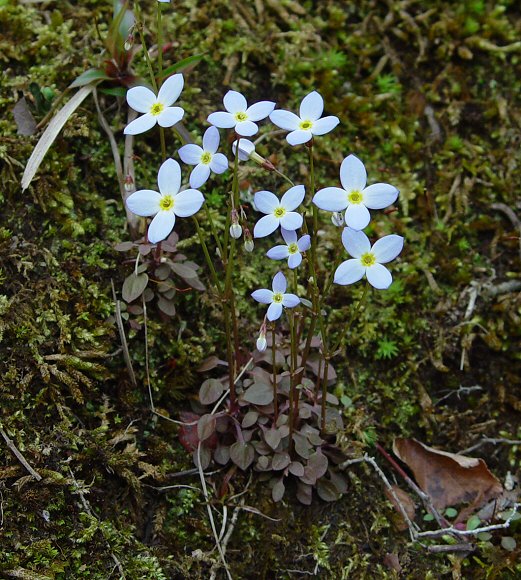Houstonia caerulea L.
Big Bluets

Native
CC = 6
CW = 3
MOC = 18
© DETenaglia
Houstonia caerulea L.Big Bluets | |
 |
Native CC = 6 CW = 3 MOC = 18 |
© DETenaglia |
|
Family - Rubiaceae Habit - Annual or perennial forb, often producing short, inconspicuous, threadlike rhizomes. Stems - Strongly ascending to erect, 1 to several, 3-15 cm long, glabrous or slightly roughened.
Leaves - Opposite and frequently also in a basal rosette, sometimes slightly succulent. Stipules 0.5-1 mm long, oblong to broadly triangular, truncate to broadly pointed at the tip, entire or minutely glandular along the margins. Leaf blades 3-15 mm long, 1-3 mm wide, oblanceolate to narrowly oblong-spatulate, rounded or broadly pointed at the tip, angled or tapered at the base, the margins entire and generally flat, the upper surface glabrous or sparsely hairy, the undersurface glabrous, without visible venation or sometimes the midvein visible.
Inflorescence - Flowers solitary in the axils of the uppermost pair of leaves, thus appearing terminal and often in pairs, on stalks 15-50 mm long. Flowers distylous. Flowers - Calyx lobes 4, 1.5-2.5 mm long, sometimes slightly unequal, up to 1/2 as long as the adjacent corolla tube, triangular. Corollas trumpet-shaped, sky blue to light blue, rarely white, usually with a yellow contrasting ring at the top of the throat, externally glabrous, internally pubescent in the upper part of the tube, the tube 4-7 mm long, the 4 lobes 5-8 mm long, lanceolate to triangular. Stamens 4, attached near the top or the base of the corolla tube, the anthers exserted or not. Ovary fully inferior, 2-locular, the ovules several to numerous in each locule. Style 1, slender, relatively long or short, exserted or not, the stigmas 2, linear.
Fruits - Capsules 2-3 mm long, 3-5 mm wide, subglobose to depressed-obovoid, somewhat flattened laterally, partially inferior, sometimes slightly 2-lobed, glabrous or nearly so. Seeds 0.5-1.0 mm long. Flowering - April - May. Habitat - Woodlands including post oak land, streambanks, roadsides, ledges, meadows, frequently in seepy or ephemerally wet spots, often on poor and/or acid soils and even growing mixed with mosses. Origin - Native to the U.S. Lookalikes - H. pusilla. Other info. - This little species is found in scattered locations in the eastern Ozark region of Missouri. It is not very common in the state. Missouri is near the western extent of the plant's natural range, which extends eastward and northward into New England and Canada. The plant is identified by its (usually) sky-blue corollas with a yellow eye at the center. Though small, the flowers are unusually large for such a small plant. This species resembles the much more common H. pusilla, but that species has a reddish eye at the center of the corolla. H. caerulea also has a corolla tube much longer than the calyx lobes, as the image above clearly shows, whereas in H. pusilla these structures are roughly the same length. Photographs taken in Umstead State Park, NC., 3-23-03, and at Moss Rock Preserve, Hoover, AL., 3-12-06 (DETenaglia); also at Silver Mines Recreation Area, Madison County, MO, 4-28-2020 (SRTurner). |